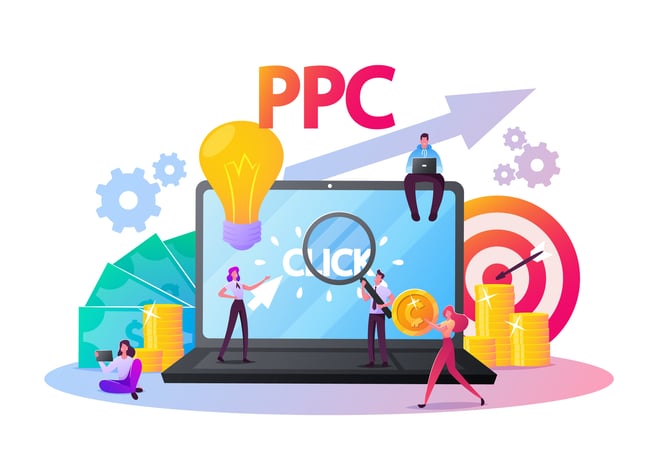Inbound Marketing Blog
for Manufacturers and Healthcare Companies
Understanding Medical B2B Search Engine Marketing
 Who doesn’t love a quick win?
Who doesn’t love a quick win?
Both established and start-up medical device companies can use a proper medical B2B search engine marketing strategy in order to see consistent business growth. For companies with a fledgling online presence and poor organic traffic numbers, paid search advertising acts as a booster seat so others can see you above the table. (The table being page 1 of Google search results.)
Once you understand how to develop a paid search strategy, you’ll need to take actionable steps to implement it. Lucky for you, we’ve got all the information you need.
Medical B2B Search Engine Marketing: Steps for Success
Search engine marketing is an effective way to force your way to the top of Google’s search results pages. Sometimes referred to as SEM, search engine marketing is often confused with search engine optimization (SEO).
Here’s a simple breakdown of the difference between the two:
- SEO -- Uses organic (non-paid) methods to help you appear in search results.
- SEM -- Uses paid advertising to help you appear in search results.
Search engine marketing is also known as pay-per-click advertising. This is a process in which businesses bid on specific keywords in an attempt to earn ad space for queries relevant to them.
Knowledge is power. And understanding what goes into being successful with medical B2B search engine marketing gives you a huge advantage over your competitors.
To better understand how to market in the B2B medical industry, follow these steps:
- Determine your audience
- Develop an ideal buyer persona
- Set KPIs
- Produce quality content
- Track data & make adjustments
Determine Your Audience
If the question “Who is your ideal audience?” leaves you blinking aimlessly into the dark abyss, then you’re likely not going to gain any traction through healthcare search engine marketing. Not yet, at least.
Determining your target audience helps you personalize your marketing efforts and develop a strategy that is made to target them. This will send the right type of lead down the correct path, rather than wasting your time on bad-fit sales conversations.
While you’re determining who your target audience is, ask yourself these questions:
- Who has buying power in their company for my product/service?
- Who does my product or service help, and who is their end customer?
- What industries does my product or service serve?
- How do people in those industries get their information?
These are just a few of the many questions that you can ask your sales team and current “great-fit” customers to help determine your target audience. Once you’ve got a good general idea of who you’ll target, it’s time to narrow that focus down and create an ideal buyer persona.
Develop an Ideal Buyer Persona
A buyer persona is a semi-fictitious profile of what your ideal customer looks like. And we don’t mean what they physically look like (unless that’s somehow relevant to your product). We’re talking about their job responsibilities, wants, needs, pain points, research methods, and so on.
Buyer personas are different in every industry. For example, a SaaS buyer persona will be much different than, say, a metal manufacturer’s buyer persona. However, the process of creating these personas is fairly similar -- asking customer-centric questions to both your own team and your buyers:
- What is their role within the company and their place in the hierarchy?
- What is their educational background and experience level?
- What are their problems and opportunities your product/service can help with?
- When looking for a solution to their problem, what quality is their highest priority (price, lead time, etc.)?
- How do they define their problem when searching it in Google?
By answering these questions from the perspective of your ideal customer, you’ll build a better buyer persona.
Set KPIs
KPIs, or key performance indicators, are crucial for your paid medical marketing strategy. They are literally how you’ll measure success.
Your KPIs are set by you, and should reflect what you consider to be good indicators that your marketing strategy is seeing success. For example, a KPI for a healthcare pay-per-click strategy may be an increase in clicks month-over-month.
This is a good time to set some SMART goals as well. This stands for:
- Specific
- Measurable
- Achievable
- Relevant
- Time-bound
SMART goals serve as a tool to help you create certain standards and criteria that will lead to you achieving your goals. Once you have them planned, put another plan in place to achieve them.
Make sure that you or your external PPC agency are choosing specific milestones that are relevant to your business and based on data. If the goals you create have no data to back them up, you could be setting yourself up for failure due to them being unrealistic.
Frequently revisit your KPIs to ensure they are directly linked to your overall business goals and strategies.
Produce Quality Content Marketing
We mentioned earlier that the creation of your buyer persona will establish a clear path for your marketing efforts. And this can’t be more true than when it comes to the content you produce -- what to write about, how to share it, and, most importantly, how to drive traffic to it.
A key part of a successful search engine marketing strategy is knowing what you will promote with your paid search budget. What types of content or web pages will you try to push traffic to? This could include:
- Landing pages
- Blogs posts
- Product/service promotions
This decision is based on what your overall goals are. If you’re simply trying to increase traffic, try directing your visitors to blog posts. If you’re trying to drive more conversions, then product offers and requests-for-quotes may be better.
And the best thing about paid marketing is that you can drive traffic to as many pages or blog posts as you want -- as long as it fits in your budget.
An effective pay-per-click ad is one that ensures your keywords and ad copy are consistent with the content of the page you are sending your reader to. This is referred to as congruence.
Ad congruence and quality content can all fall under the umbrella of content marketing and should be tailored for each stage of the buyer’s journey:
Awareness Stage
Content in the awareness stage should be focused on helping your audience realize they have a problem or opportunity.
Instead, this content should focus on common pain points that exist within the industry. For medical B2B marketing, this could be issues with billing or risk aversion. Sometimes your persona simply needs help defining their problem or opportunity before they can attack it -- that’s where awareness-stage content comes in.
Consideration Stage
At this point, your audience has already identified their pain points, and are ready to begin considering solutions.
This is where your content can start to educate your audience on your solutions vs. the “other guys’” solutions. This is key for establishing trust with your reader, and showing them that you have their priorities in mind.
Just remember that even though you may be comparing potential solutions or products, your content should remain educational and relatively unbiased.
Decision Stage
Your decision-stage audience is now ready to make their final purchasing decision and move forward.
This is a good opportunity to use video marketing, case studies, and other forms of content to help reinforce your product or service. Videos allow for virtual tours, product demos, and personalized sales email outreach. Case studies are vital signs that you have concrete data and results to show your high-stakes medical product is safe and effective.
Track Data & Make Adjustments
What’s the point in all this marketing if you don’t study your data and make adjustments based on it?
Your data can be tracked, stored, and viewed in many different ways. One of the best (and most simple) ways to do this is through CRM software.
Data such as clicks, impressions, blog views, user search queries, and more all play a big role in how you evolve your medical marketing strategy. And seeing all this laid out in front of you will give you a good understanding of what’s working and what’s not.
Start Improving Today
Search engine marketing, specifically pay-per-click advertising, is great for growing new businesses as well as giving older businesses facing traffic declines a kick in the pants.
Although PPC requires you to dedicate a part of your marketing budget toward it, it’s a nice bridge tactic as you concurrently work on building long-term organic traffic growth. Over time, you can reduce or even eliminate PPC spending as your organic content efforts take off.
Hopefully this article has prepared you to take the next step in your medical digital marketing strategy. If you’re still not sure where to start, or maybe aren’t even sure where you’re at in the process, always remember that it never hurts to get back to the basics.
One of the best ways to do this and ensure you’re on a path to success is to learn how to properly apply your buyer persona to your marketing strategy. Download our free e-book below:
Our Blogs, Direct to Your Inbox!
How to Audit your Online Marketing
If you are executing digital marketing, congratulations! You are most likely already one step ahead of your competition, and making strides to meaningfully connect with prospects online. But, how do you know if you’re seeing continual success year over year, and improving your metrics?
Without the tools in place to analyze and benchmark your efforts, it is impossible to scale your online marketing and ensure continuous success.


